
AmeriFlux showcased the Year of Methane action year at the 2019 Annual Meeting with an oral session, methane posters, and three methane breakout discussions.
Ruminants, Forests, and Wetland Management
The Year of Methane talks illustrated the variety of new directions enabled by methane flux measurement. Dave Hollinger, a Forest Service research scientist, gave the invited keynote on the methane sink strength at Howland Forest, finding soil moisture was the primary driver of interannual variability, with very wet years enough to turn the upland system into a net source. Alex Valach, a Baldocchi lab postdoc, quantified the potential of temporary water-table drawdowns below the surface in a restored California marsh, to mitigate methane emissions, finding that early-season events could reduce annual emissions by almost 50%. Paul Stoy then explained how American bison populations are rebounding after near extinction, and how he uses eddy covariance to estimate their contemporary role in ruminant methane emissions. The speaker session concluded with a presentation from Gil Bohrer, whose talk touched upon a recurrent theme throughout the meeting: that we can’t assume spatial homogeneity of fluxes within the tower footprint. In his talk, Gil described an approach to attribute methane flux among different wetland patches that differed greatly in methane efflux, with some surprising results that plant functional type is not a ready predictor of methane transport traits.

Figure 1: (a) Patch level heterogeneity at US-OWC wetland (Morin et al. 2017) and (b) methane emissions from different patches (Rey-Sanchez et al. 2018).
New Sites, New Methane Measurements
The first Year of Methane breakout session on new methane sites and measurements illustrated opportunities and challenges associated with methane fluxes. Six sites were summarized in lightning talks, covering a range of bioclimatic conditions and two of which had been supported by the loaner LiCOR 7700 analyzers. From north to south they covered the Alaskan tundra (US-NGB/C), a salt marsh in Massachusetts (US-PLM; a loaner 7700 site), rice paddies in Arkansas (US-HRA/C), plantation forest wetlands on the North Carolina coast (US-NC2/3/4), a Peruvian humid tropical forest, and forested peatlands in the Valdivian rainforest, Chile.
Common themes emerged: the challenges of generating enough solar energy for the power-hungry 7700 cleaning cycle, concerns about the validity of the net zero dry-air flux assumption in wetland ecosystems, as well as considerable excitement about contributing to the understanding of the global methane cycle, including the potential for climate change mitigation. The need for AmeriFlux to support PIs working in remote areas was also highlighted, both by encouraging new methane observations in under-represented areas, such the humid tropics, and to assist when instruments need repair, when they typically need to be shipped back to the USA.

Image 2: An anthropogenic peatland, formed after clear-cutting, in the Valdivian rainforest of southern Chile (Photo: Jorge Perez-Quezada)
The Future of Methane in AmeriFlux
Methane biogeochemistry and ecological interactions was the focus of the second Year of Methane breakout. Rodrigo Vargas facilitated the discussion, with topic contributions from three AmeriFlux PIs. Lisamarie Windham-Myers, a USGS scientist based in Menlo Park, CA, prompted the group to consider the underappreciated role of water transport dynamics (i.e., advection versus diffusion) on wetland oxidation state, and in turn rates of methanogenesis. Ankur Desai and Gil Bohrer reiterated the need to consider flux heterogeneity across different spatial and temporal scales, challenges of measuring low methane emissions or sinks, and the key role of freshwater lateral transport of methane and promotion of microsite anerobic conditions especially in wetlands. Finally, Danielle Christianson, from the AmeriFlux Data Team, explained the pathway forward for incorporating new methane-related variables into data submissions. She emphasized that adding hourly or half-hourly data variables to the core datasets is much easier than adding new BADM and reminded us that most of the latter has historically constituted spatial averages, rather than spatially explicit raw data. The discussion ended in a somewhat open-ended manner, with the group wondering what the future additions to existing or new data products should look like, such as the inclusion of variables to allow the user to calculate flux footprints for analysis, to better link the spatial heterogeneity with fluxes from different ecosystem patches.
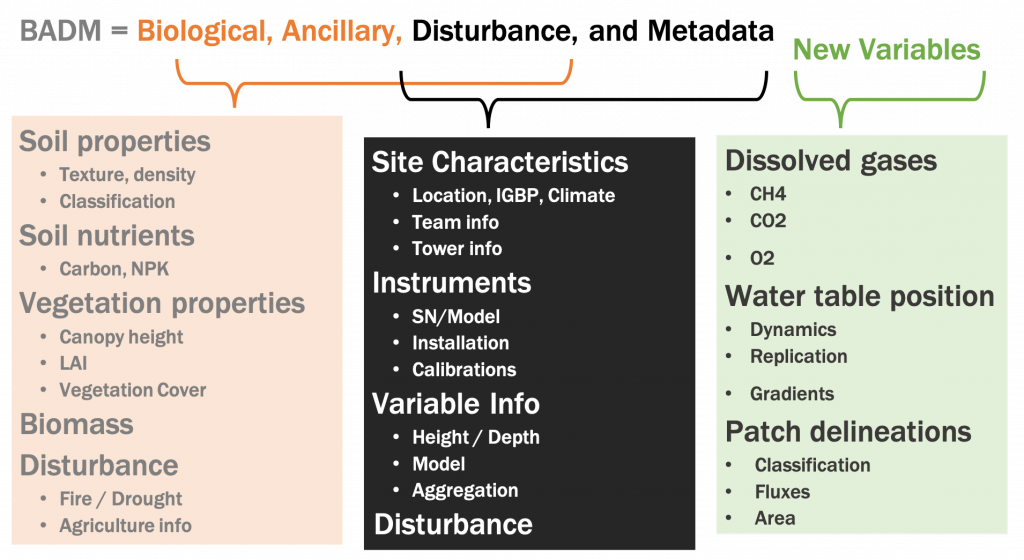
Figure 2: Existing BADM variables (left, center) and proposed new variables (right). Some methane variables, such as continuous dissolved gas data, may best be reported in BASE submissions, rather than BADM.
Methane Posters
The first day of the AmeriFlux meeting concluded with poster presentations, including several methane-themed displays. I (Gavin McNicol) presented an update on the FLUXNET-CH4 synthesis activity, which has now produced its first publication in the Bulletin of the American Meteorological Society (Knox et al. 2019). The synthesis is preparing to tackle the main goal of a globally gridded wetland methane flux product and we are conducting key preparatory analysis, including an exploration of the bioclimatic representativeness of the network and the performance of a data-driven prediction approach developed by the FLUXCOM initiative and previously applied to carbon dioxide and energy fluxes. A poster by Benjamin Runkle, expanded on his talk during the first breakout, explaining that carefully timed water-table drawdowns can mitigate as much as 64% of annual methane emissions from rice paddies. A third poster by J. William Munger used forest canopy profile measurements of methane to understand the balance of soil uptake and tree stem emissions in Harvard Forest. He found wet soil pockets, such as abandoned beaver ponds, and tree stems occasionally functioned as weak methane sources, underscoring the emerging view that upland forests surfaces function both as sources and sinks.
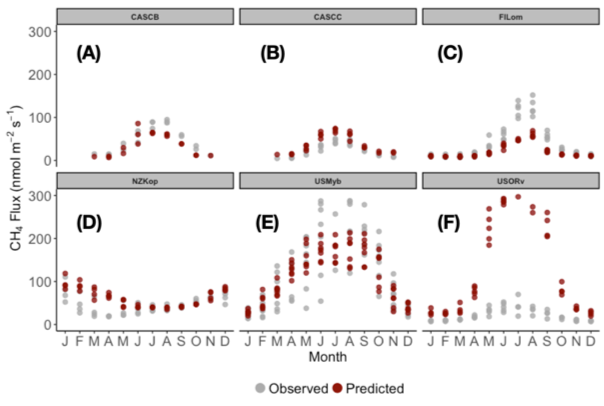
Figure 3: Examples of data-driven model performance at FLUXNET-CH4 sites (multiple years stacked). Simple symmetric seasonality is well-captured in two Boreal wetlands (A,B), but is under-estimated (C), or lagged (D), in two temperate bogs. Mean seasonal cycle in a temperate marsh (E) is well captured, while interannual anomalies are under-estimated. In some cases (e.g., F) predictions are very inaccurate, suggesting missing drivers in the predictor features.
Regional and Global Methane Syntheses
The final Year of Methane breakout session connected AmeriFlux to other scientific communities that are undertaking methane syntheses. James Holmquist from the Coastal Carbon RCN (CCRCN), Eugenie Euskirchen from the Permafrost Carbon Network (PCN), and Kyle Delwiche from the USGS Powell Synthesis for Wetland Methane (Powell), joined remotely via Zoom and provided an overview of their activities. The CCRCN is in its second year of five and is now focused on a coastal wetland methane (led by Patty Oikawa at Cal State East Bay), which they have identified as contributing the most uncertainty to coastal climate interactions (Holmquist et al. 2018).

Figure 4: CCRCN compiled data on salinity effects on coastal wetland methane emissions and found that the zero-emission threshold is approximately ~15 ppt (Holmquist et al. 2018).
The PCN has a pan-Arctic methane synthesis as a long-term goal but is focused for now on completing similar work for carbon dioxide and has been collating chamber and eddy covariance data for this effort in the past several years. A key outcome of this discussion was to ensure good data provenance by using AmeriFlux (and other regional networks) as the primary repository for synthesis data.

Figure 5: Chamber (blue circles) and EC tower (orange circles) data compiled across the Arctic for the Permafrost Carbon Network’s carbon dioxide synthesis activity (Eugenie Euskirchen, PCN).
Finally, the Powell activity is pursuing synthesis work spread across two workshops, the second of which will be held in February 2020. The activity is already generating exciting results, including the characterization of seasonal hysteresis in methane temperature dependencies and identifying the direction and timescale of methane driver relationships using information theory. Though workshop attendance is closed to new participants, collaboration with the different working groups was encouraged for interested PIs.
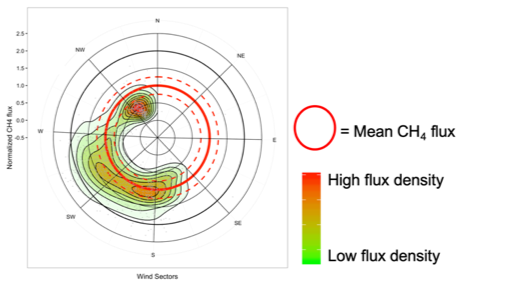
Figure 6: Spatial heterogeneity can bias EC estimates of methane emissions (Analysis by Mathias Göeckede).
Wrapping up the Year of Methane
While the loaning of LiCOR 7700 instruments and free calibration gases will continue for the remainder of the Year of Methane as core support mechanisms, the AmeriFlux meeting also showed the importance of providing a platform and an attentive audience for AmeriFlux PIs and early career scientists to talk about their experiences measuring methane fluxes with eddy covariance. A multitude of methane stories are already being written, reflecting the passion and diversity of the AmeriFlux community, and, over the remaining months of the Year of Methane, we will continue to share them.
References
Holmquist JR, Windham-Myers L, Bernal B, Byrd KB, Crooks S, Gonneea ME, Herold N, Knox SH, Kroeger KD, McCombs J, Megonigal JP, Lu M, Morris JT, Sutton-Grier AE, Troxler TG, Weller DE. 2018. Uncertainty in United States coastal wetland greenhouse gas inventorying. Environ Res Lett 13. doi.org/10.1088/1748-9326/aae157
Knox SH, Jackson RB, Poulter B, McNicol G, Fluet-Chouinard E, Zhang Z, Hugelius G, Bousquet P, Canadell JG, Saunois M, Paple D, Wohlfahrt G, Zona D. 2019. FLUXNET-CH4 Synthesis Activity: Objectives, Observations, and Future Directions. Bull Am Meteorol Soc. doi.org/10.1175/BAMS-D-18-0268.1
Morin TH, Bohrer G, Stefanik KC, Rey-Sanchez AC, Matheny AM, Mitsch WJ. 2017. Combining eddy-covariance and chamber measurements to determine the methane budget from a small, heterogeneous urban floodplain wetland park. Agric For Meteorol 237–238:160–70. doi.org/10.1016/j.agrformet.2017.01.022
Rey-Sanchez AC, Morin TH, Stefanik KC, Wrighton K, Bohrer G. 2018. Determining total emissions and environmental drivers of methane flux in a Lake Erie estuarine marsh. Ecol Eng 114:7–15. doi.org/10.1016/j.ecoleng.2017.06.042

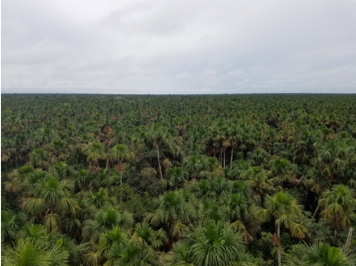

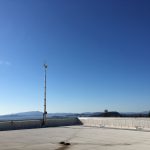

No Comments
Be the first to start a conversation